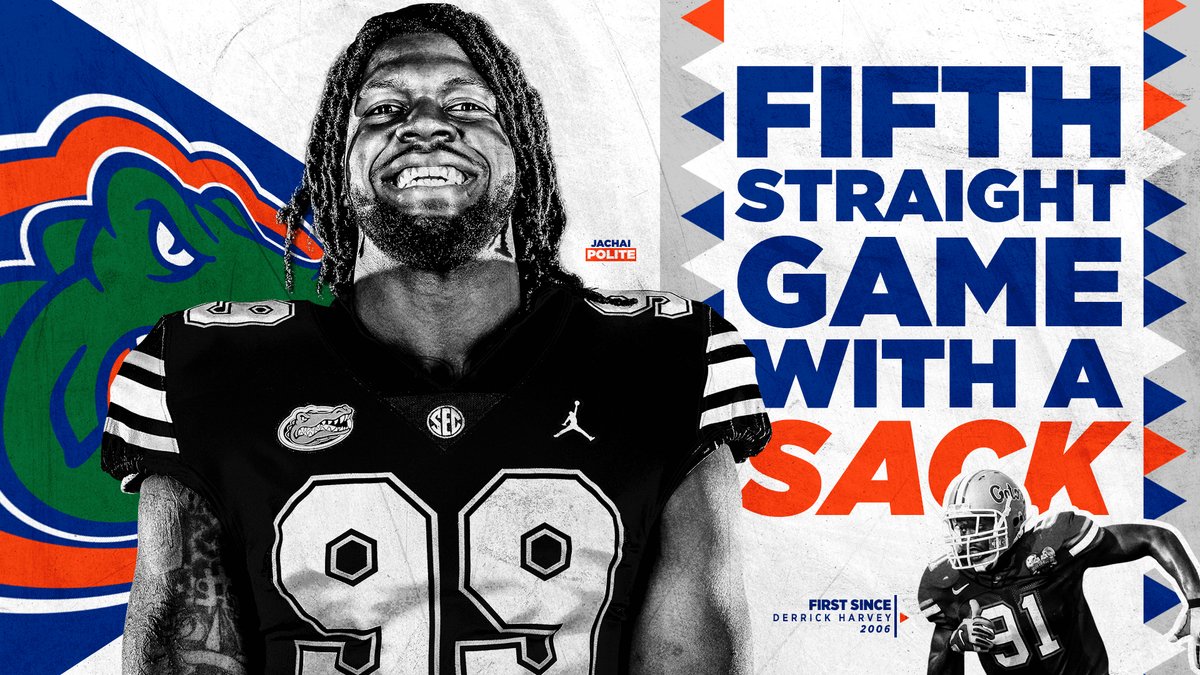The college football season is always filled with creative and social inspiration. Every year, without fail, football programs raise the bar with their graphics, their hype
The Florida Gators are a
Visual identity only they can own.
It’s important that teams put in the effort to define a visual identity in today’s crowded space. It makes content stand out above the crowd and eventually because recognizable for fans.
The Florida Gators not only created a visual identity, but they created one that only they can own. In their design, they leverage the teeth from their Gator logo as a consistent element throughout all their graphics. The use of the teeth is a distinction unique to them. Combine that with their bright colors and strong composition and the result is a strikingly sharp and eye-
.@18franks ➡️ @VanJefferson12
— Florida Gators Football (@GatorsFB) October 13, 2018
One-point game. #GoGators #RelentlessEffort pic.twitter.com/18k7P8ykAe
.@dstiner3 called game. Again.
— Florida Gators Football (@GatorsFB) October 6, 2018
Can't spell dub without DBU. #GoGators pic.twitter.com/2W8Sezo2Gz
🕰️: 6 PM
— Florida Gators Football (@GatorsFB) September 29, 2018
📺: @espn
💻📱👀: https://t.co/JaAqjNN8Qt
📻: https://t.co/4KvjavLmdk
📊: https://t.co/EV0Ou89vtC pic.twitter.com/6Y7JUsar2z
Videos made for social.
The Gators have stepped up their video game. They leverage everything from powerful emotion, inside access and their own game footage to provide access and content for fans. Each piece serves a unique purpose and they are extremely thoughtful about the creative execution.
It’s hard to pick out one thing they’re doing well across video because it’s all so engaging. So, take a look at their vast portfolio and get inspired.
Enjoying the Ws had a guest star today 😂 pic.twitter.com/d7ZwrXJLjR
— Florida Gators Football (@GatorsFB) October 13, 2018
The run that put us ahead for good 👊 pic.twitter.com/q82qyd1eJV
— Florida Gators Football (@GatorsFB) October 14, 2018
"Success occurs when opportunity meets preparation."#GatorStandard 🐊 #UFvsVANDY pic.twitter.com/CQeiJGoSS2
— Florida Gators Football (@GatorsFB) October 11, 2018
📍Nashville 🛬#GoGators 🐊 #BeatVanderbilt pic.twitter.com/1t6gaFdrSa
— Florida Gators Football (@GatorsFB) October 12, 2018
.@B_Stew5 called GAME! #FastPhysicalAggressive 🐊💪 pic.twitter.com/CfOCkpFzHB
— Florida Gators Football (@GatorsFB) October 11, 2018
We’re getting pretty good at enjoying Ws 😁 pic.twitter.com/g8ouDlVQHy
— Florida Gators Football (@GatorsFB) October 7, 2018
Enjoying another W! pic.twitter.com/S2NuiGqDId
— Florida Gators Football (@GatorsFB) September 23, 2018
Original reaction GIFS/content.
There is a big debate in the social and sports world about pop culture GIFS and memes. To share or not share? I’m a big believer that teams and brands should lean away from content that isn’t unique to their brand, and instead, work to create original content that evokes the right reaction and emotion.
It’s not easy to create content that is relatable for the moment. It’s a creative exercise that takes time and the desire to test and learn.
The Florida Gators have had some strong moments where they created content that taps into the emotion of the moment, whether it’s humor or hype. The below are good examples of how original content can win
FAKE PUNT FIRST DOWN RUN!pic.twitter.com/3amZYSthfz
— Florida Gators Football (@GatorsFB) October 13, 2018
🤷♂️@GatorsFB #GoGators#DBU pic.twitter.com/uLEHgG5cHA
— Florida Gators (@FloridaGators) October 7, 2018
MOOD. pic.twitter.com/WYFg66gZku
— Florida Gators Football (@GatorsFB) October 7, 2018
If you’re interested more on the topic of pop culture GIFS and memes, check out this post here.
Intentional execution.
As mentioned briefly, the Gators focus on their creative execution and doing it right. They design intentionally and with the platforms in mind. The details and nuances matter. A great example of this is their “win tweet” execution, where they leverage four photos to form one larger graphic on mobile (and if you aren’t on mobile still looks sharp).
Bringing a 4-1 record back to Gainesville!#GoGators #RelentlessEffort pic.twitter.com/d1ickcd0sZ
— Florida Gators Football (@GatorsFB) September 30, 2018
The Gators also do a fantastic job creating for the six-second loop feature on Twitter. They can tell a story in less than six seconds. And, they know the type of content that’s so memorizing you want to watch it on loop forever. Below are a few examples.
All right, let’s go! #GoGators #LSUvsUF pic.twitter.com/v5R85lvk4w
— Florida Gators (@FloridaGators) October 5, 2018
Only GATORS get out alive – thanks to YOU! #GoGators pic.twitter.com/iprGrG06tC
— Florida Gators (@FloridaGators) October 7, 2018
#DoYourJob 💪 #RelentlessEffort #GatorStandard 🐊 pic.twitter.com/Eom6bcZKmM
— Florida Gators Football (@GatorsFB) October 2, 2018
The bottom line is this: Concepts are important, but how we package and execute is also key. Leverage every platform’s different strengths to create content that is eye-catching, engaging and unique to the platform.
If the Gators FB social (and the athletic department in general) are not on your radar, it’s time to put them there. From their strong visual identity to their intentional creative executions, they’ve found a way to shine and capture the attention of their fans. Follow them here: Twitter, Instagram
What other college football programs have caught your eye this season? I would love to hear your thoughts below!













